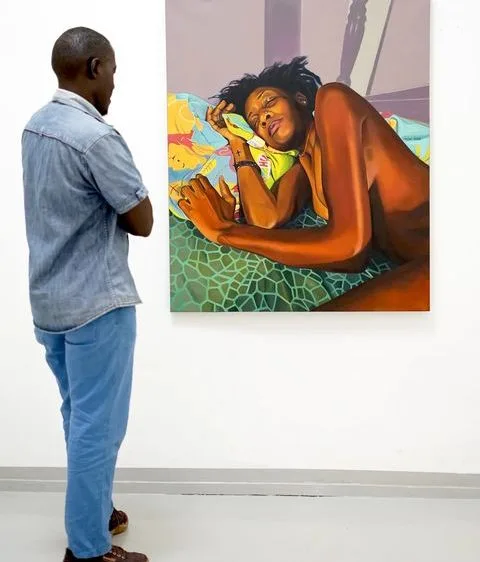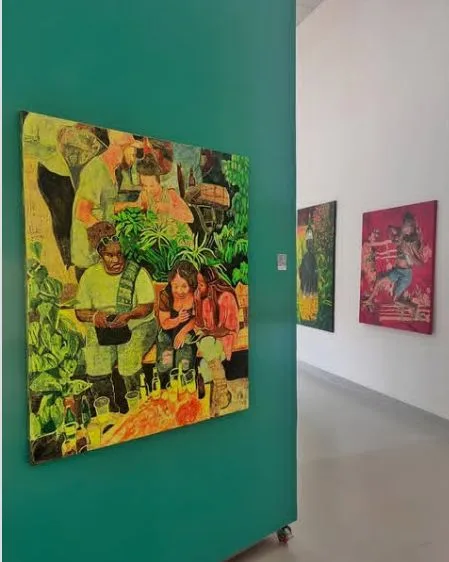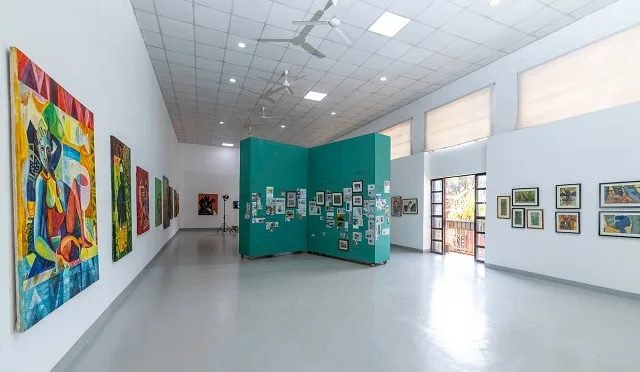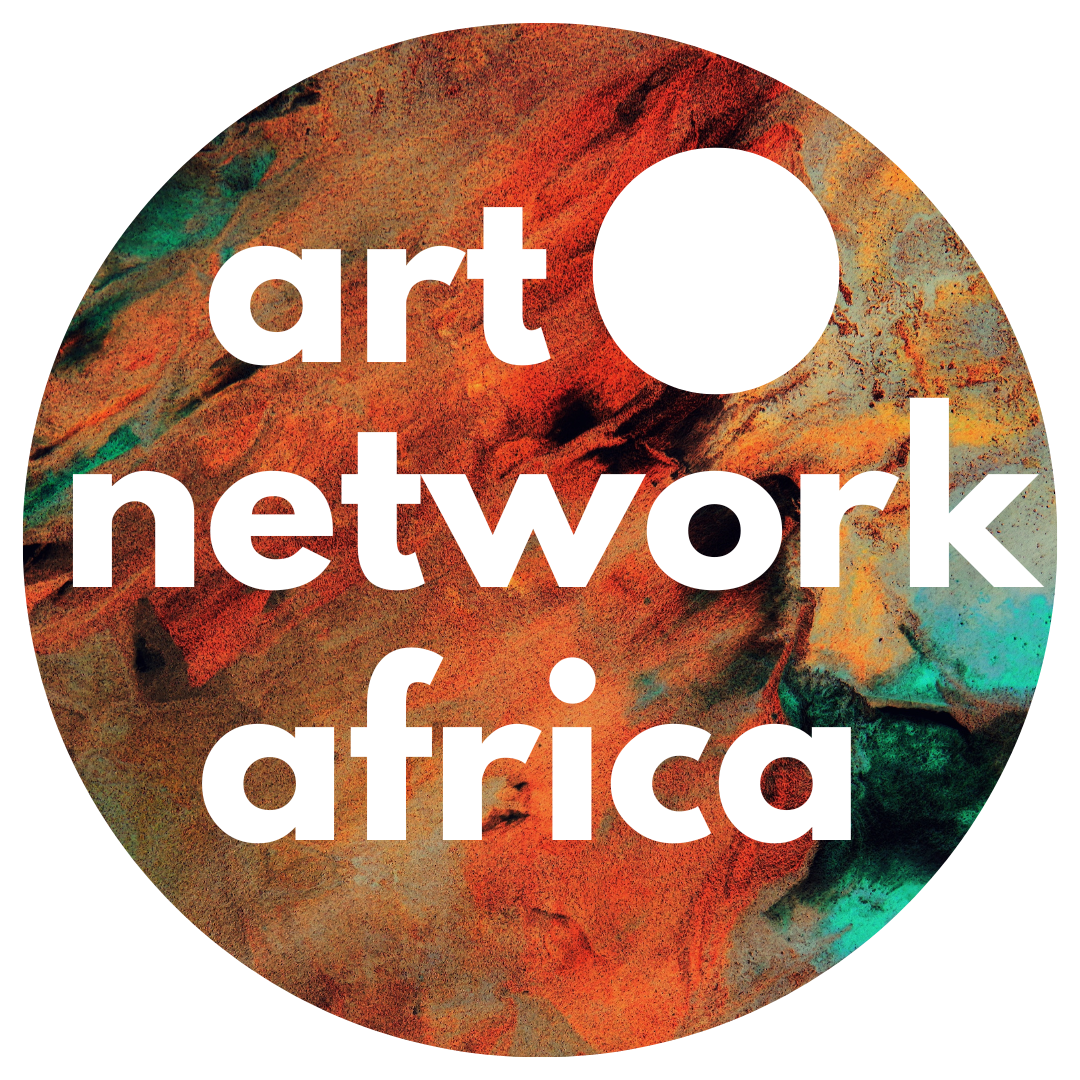Henry ‘Mzili’ Mujunga and Afriart Gallery present ’25 years: 1999-2024′, a colourful exhibition filled with thought provoking multiple media on canvas. In realistic and semi-abstract forms, Mujunga explores a spectrum of human experiences; from the celebrated to the taboo- the common place and the hidden.
Mostly an abstract artist in his earlier works, Majunga imposes his interpretation of the world on the work while the murkiness of his latest exhibits invites the viewer to be a co-creator. Exploring gender and sexuality as his thematic fabric, he takes on taboo topics. In muted colours as if to reflect their surreptitious existence, in woodcut prints ‘Eve and Eve’, 2002 and ‘Adam and Adam’, 2002 he catches same-sex figures in seemingly compromising positions. The topic of homosexuality has been an undercurrent in Ugandan communities, from the lore of Ugandan kings and their page boy lovers to the current situation where the orientation is illegal in the country. Such is the nature of his practice, one carved from subject matter pertinent both in social setting and current social attitudes for local Ugandan communities.

Pieces like ‘Gogolo II’, portray a popular childhood game to evoke universal nostalgia while on the opposite side of the spectrum, ‘Bodily Desires’, speaks to the adult experience, illegibly spotting a naked man and woman.
Works like ‘Buffalo Woman’, – in which a seemingly stoic woman is adorned with the horns of a buffalo was inspired by the popular African Woman magazine started in 2005 that explored fashion, people and culture while ‘African Mona Lisa’, serves as a celebration of their strength and beauty. According to Henry Mzili Mujunga, he admires the strength that is in women’s ability to still live authentically; to laugh loudly and cry when they need to.
Mujunga, like many others trained at Margaret Trowell School of Industrial and Fine Art (MTSIFA), grappled with authentic expression as an artist trained in western techniques but, desiring to produce art for local consumption, has crafted a new artistic form which he calls indigenous expressionism. It is an art practice guided by Pan- African ideals in which African narratives, objects and techniques are used. Indigenous expressionism is one of the many ways in which Mujunga has and continues to influence the art scene in Kampala and East Africa.

Under the bright gallery lights, his later works evoke exuberance, even freedom in realism and saturated colours- giving an impression of a culmination of Mujunga’s artistic practice both in confidence and a mastery of material. In titular and composition reference to the famous painting by Leonardo Da Vinci, ‘Salvator Mundi’ is a self-portrait . From his position on the wall, he seems to look over his empire confidently and powerfully- a master of his world. In other pieces like ‘Nature play: Bya Muzanyo I’, two girls are portrayed play fighting so vividly they could have been photographed in the grass and the typical Ugandan social scene while conversation over drinks is captured in ‘Crowd control Gossip.’
A salon wall style display of news articles, like a centerpiece to the exhibition, displays narrations to the journey Henry Mzili Mujunga has taken as an artist starting at birth, through his admission to and works at Makerere University, captured in old photographs of a younger Mujunga working gleefully in the school studios. Also showcased are his years as a sculptor commissioning works for Mulago Hospital, Complex Hall at Makerere University and Silver Springs Hotel all of which are still serving their landscaping duties today.

Majunga’s first public confrontation of social issues stands out here in his 2001 exhibition in which he challenges the women empowerment movement just as it gained momentum in the region, in stylised paintings of women with angry and ugly facial features and drab colours. He doubles down on his views in interviews, which are also captured on the wall, stating that the outspoken women are “ a turn off” recalling the early century attitudes of Ugandans towards this movement when many were unable to look past the aesthetics of the women activists- as though it were a poorly executed beauty contest.
There are documentations of the artist’s residencies in Europe as well as his travels in East and West Africa, from which he made exceptional collaborations leading to the birth of Index Mashariki, an incipient collective of East African artists under whom Art and Culture was taken to the next level in the region.
A total summation of Mujunga’s contributions is inexhaustible; like a true leader and educator, he has instructed and natured the art and culture scene in Uganda and East Africa. From staging and conducting the first print workshop, Kuona Print Exhibition in 2002 in Nairobi where he trained a new generation of artist under the project Surfaces in collaboration with Afriart Gallery, to championing for causes such as a national museum and a national collection as the vice president of the Uganda Arts’ Association. ’25 Years’ reflects Mujunga’s journey; his successes and challenges, and therefore the reality of the arts in the 21st century in Uganda and East Africa. ’25 Years’ initially closed on the 1st of February but has been extended to the 28th of February 2025 at Afriart Gallery in Kampala, Uganda.


